(Blog post written by Sally Tapp)
It’s amazing how time flies when you’re on fieldwork!
I have been on Skye for three weeks now (although it feels like about five minutes) and have settled into a lovely routine.
Firstly, to introduce myself. My name is Sally Tapp and I graduated from SMRU with a Master’s in Marine Mammal Science in 2013. Since then, I have worked in the marine conservation sector on a variety of different projects. It all started with a traineeship at Cumbria Wildlife Trust where I had the opportunity to live on Walney Island, just off the coast of Barrow-in-Furness, and study the colony of grey seals that live there. Following this, I headed to Aberdeen and the RSPB’s Dolphinwatch project, focussing on the east coast population of bottlenose dolphins that can be seen regularly at Aberdeen harbour. After that, back down south of the border I worked for Lancashire Wildlife Trust’s Living Seas Team on a long-term project to secure the designation and management of Marine Conservation Zones around England and Wales, with the aim of protecting vulnerable marine species and habitats and halting any further decline in the condition of our marine environment. Before starting my new role here with the Harbour Seal Decline Project, I was based at the Dove Marine Laboratory in Cullercoats, working for Newcastle University as their Marine Education Officer.
Now to the interesting part…. The photo ID data collection here on Skye is all done from a small wooden boat run by Dunvegan Castle. During the summer months they run a highly popular seal trip around the inner skerries of Loch Dunvegan, giving tourists the chance to get up close to the harbour seals and see these beautiful animals hauled out on the seaweed, and relaxing in a way that only seals can!
This is an ideal platform from which to collect photo ID data and in previous years we have been able to join a seal trip when there is room on the boat and collect the photo ID data as it tours around the skerries. Tourists have had the opportunity to find out about the project and view the photo ID catalogue to identify some of the seals they can see whilst out on the loch. This has been invaluable, and we are grateful to Dunvegan Castle and their wonderful boat skippers for allowing us to do this.
Due to the Covid-19 pandemic, this season has been a little different and the boats are not running for the tourists yet. Therefore, each day depending on tide times I head over to Dunvegan and am treated to my own private seal tour. This means I have the chance to carefully and systematically photograph every seal that we find hauled out on the skerries. Unlike on Orkney, where John has a huge amount of kit to carry around, I just swing my camera around my neck, climb aboard the boat and away we go! I was a little nervous the first day we headed out in case I was swamped with seals, however, I was eased in gently as numbers were relatively low on my first few trips.
The seals here are very used to boats, particularly the Dunvegan boats, and are used to people passing by watching them. However, during the pandemic when the world shut down, the tourist boats here also stopped. This means that pups born last year (2020) have not had the same experience and the seals haven’t seen the boats for about a year and a half. Therefore, I was interested to see if this would affect their behaviour and how they would react to us approaching. For the first few surveys, the seals kept a careful eye on what we were doing, and they were clearly more nervous than they have been in previous years. This said, as the days have passed by, they are becoming more accustomed to us and are happy to remain hauled out.
The first week here was a bit frustrating as the weather was atrocious, with high winds cancelling a number of our trips. But by the second week the sun finally made an appearance and so did the first pup of the season. The pups arrive around mid-June each year like clockwork and this year’s first arrival was on Friday 18th June. Unfortunately, this year we can only go out on weekdays, so I was eagerly awaiting more pups on the Monday morning when I arrived at Dunvegan and I wasn’t disappointed. Many more pups had made an appearance over the weekend, the skerries were bustling with seals and the air was alive with the sound of mums calling for their pups and vice versa.

The pups are born with their unique markings, so we can identify them from day one and watch them develop as the season continues. It’s nice to see very distinctive patterns in their pelage that will be useful in subsequent years to immediately know who we are looking at. This little pup born last week has a very identifiable star pattern on its forehead (I have nicknamed it Little Star) which will prove easily recognisable in the future.
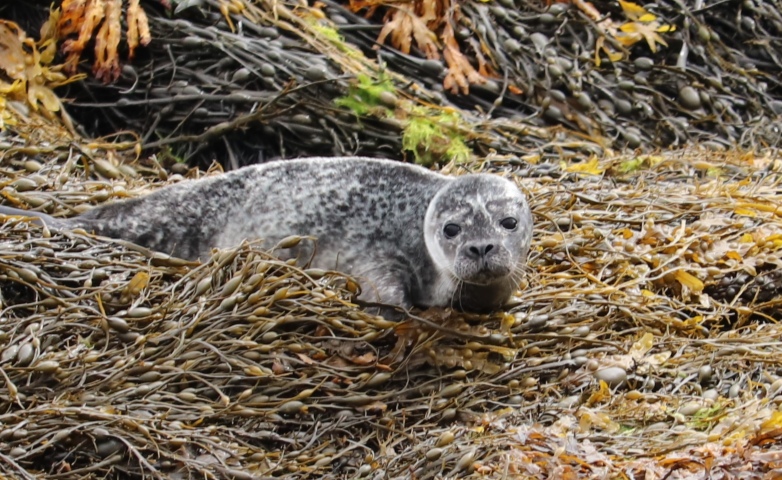
We try to get photographs of mum-pup pairs whenever possible so that we can track the mothers through the years to see whether they produce a pup each year and, if possible to follow how long the pup stays associated with its mother during the pupping season. It is such a privilege to get to see the pups interacting with their mums and forming a bond. Watching them taking their first few swimming lessons is very special with mum constantly checking that her pup is doing well with a reassuring nuzzle.
Looking back at the numbers of seals on the skerries in previous years, numbers have appeared relatively low this year. According to the skippers, since the end of the 2019 season, the number of seals around Castle Dunvegan has seemed to them to be smaller. I am interested to see how this develops as the season continues and I will update you as the next few weeks progress.
If you would like to see more pictures of the Dunvegan seals and some of the beautiful land- and sea- scapes around the Isle of Skye then you can find me at instagram.com/selkie_sally
For now, it’s bye from Skye!
Sally

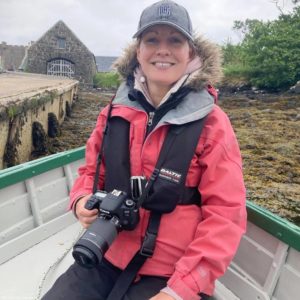
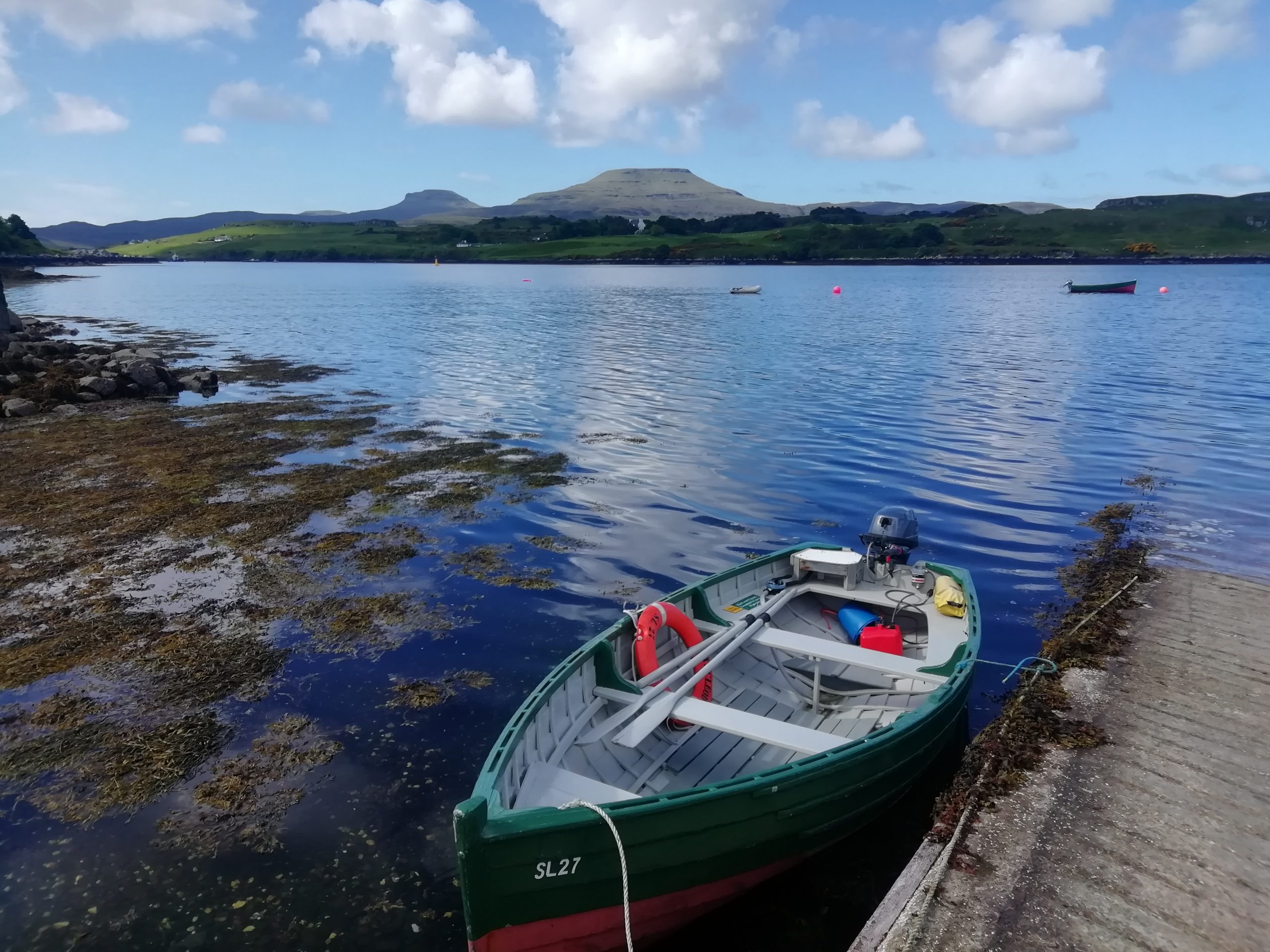
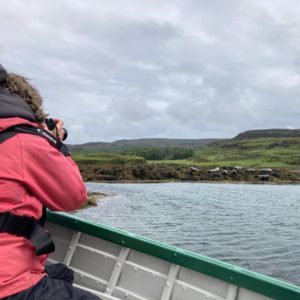
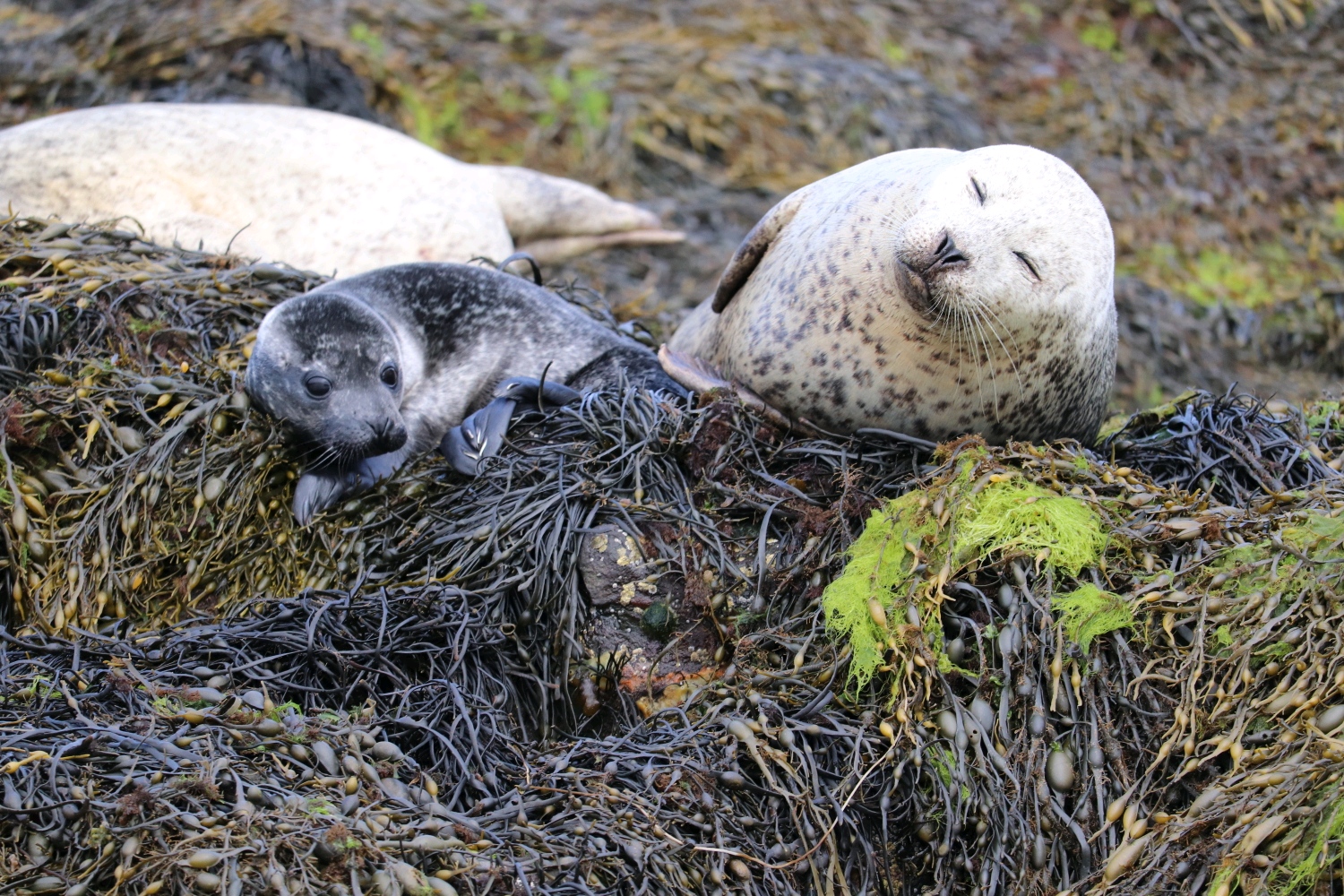

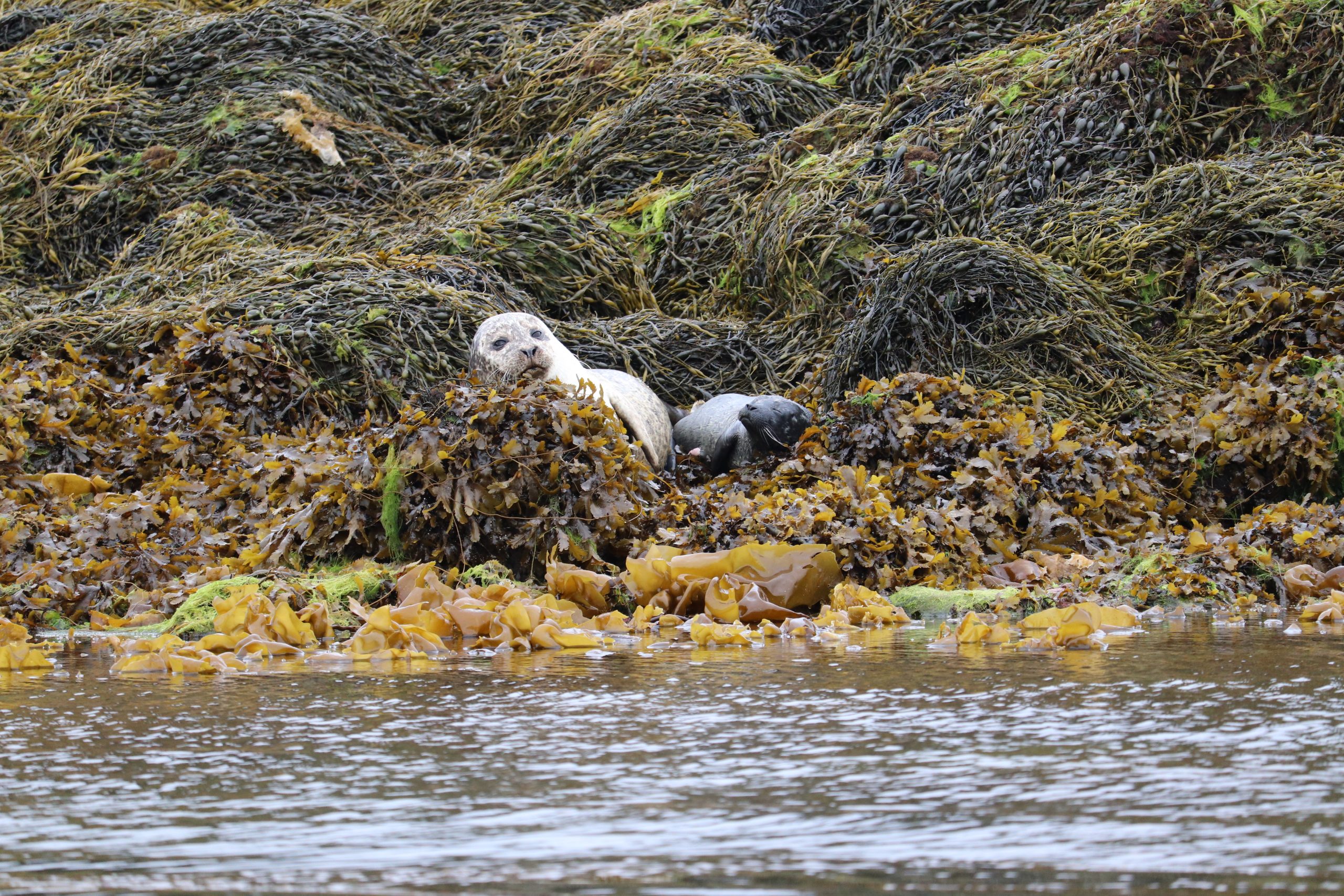
Hi, I would derelict if you could answer a question. For me. I live on the south coast and SUP. There is a pod of around 8 Harbour seals where we often go paddling. We try to keep the 100m distance but there is one seal that is very nosey and brave who always wants to engage. When I try and paddle away to keep my distance he follows. Last week when we sat him/her we were about to leave and he/she displayed some new behaviour and I wondered if you could help with what he is doing. He went quite high in the water with his nose pointing upwards and repeatedly nodded his head upwards to the sky? What does that mean? Thanks in advance
Hi Alex,
You do the right thing in trying to keep your distance, as seals in general get really spooky with paddleboards and kayaks specifically, I think because they are quiet and thus there is no previous warning on the approach. This is specially important during pupping season (June-July for harbour seals) and during the moult (around August time for harbour seals). But of course you may have individuals showing different behaviours towards an approaching paddle board. I am not sure what that specific behaviour you describe might mean to be honest. Seals are known to bobble, where they float with their heads out of the water and pointing upwards, but what you describe seems a bit more dynamic.
Sorry our reply is not quite solving the mystery!
Best wishes, Monica
search
Harbour Seal Decline Project
A SMRU Project
HOME
MENU
Over the sea to Skye
Leave a reply
(Blog post written by Sally Tapp)
It’s amazing how time flies when you’re on fieldwork!
I have been on Skye for three weeks now (although it feels like about five minutes) and have settled into a lovely routine.
Firstly, to introduce myself. My name is Sally Tapp and I graduated from SMRU with a Master’s in Marine Mammal Science in 2013. Since then, I have worked in the marine conservation sector on a variety of different projects. It all started with a traineeship at Cumbria Wildlife Trust where I had the opportunity to live on Walney Island, just off the coast of Barrow-in-Furness, and study the colony of grey seals that live there. Following this, I headed to Aberdeen and the RSPB’s Dolphinwatch project, focussing on the east coast population of bottlenose dolphins that can be seen regularly at Aberdeen harbour. After that, back down south of the border I worked for Lancashire Wildlife Trust’s Living Seas Team on a long-term project to secure the designation and management of Marine Conservation Zones around England and Wales, with the aim of protecting vulnerable marine species and habitats and halting any further decline in the condition of our marine environment. Before starting my new role here with the Harbour Seal Decline Project, I was based at the Dove Marine Laboratory in Cullercoats, working for Newcastle University as their Marine Education Officer.
Now to the interesting part…. The photo ID data collection here on Skye is all done from a small wooden boat run by Dunvegan Castle. During the summer months they run a highly popular seal trip around the inner skerries of Loch Dunvegan, giving tourists the chance to get up close to the harbour seals and see these beautiful animals hauled out on the seaweed, and relaxing in a way that only seals can!
This is an ideal platform from which to collect photo ID data and in previous years we have been able to join a seal trip when there is room on the boat and collect the photo ID data as it tours around the skerries. Tourists have had the opportunity to find out about the project and view the photo ID catalogue to identify some of the seals they can see whilst out on the loch. This has been invaluable, and we are grateful to Dunvegan Castle and their wonderful boat skippers for allowing us to do this.
Due to the Covid-19 pandemic, this season has been a little different and the boats are not running for the tourists yet. Therefore, each day depending on tide times I head over to Dunvegan and am treated to my own private seal tour. This means I have the chance to carefully and systematically photograph every seal that we find hauled out on the skerries. Unlike on Orkney, where John has a huge amount of kit to carry around, I just swing my camera around my neck, climb aboard the boat and away we go! I was a little nervous the first day we headed out in case I was swamped with seals, however, I was eased in gently as numbers were relatively low on my first few trips.
The seals here are very used to boats, particularly the Dunvegan boats, and are used to people passing by watching them. However, during the pandemic when the world shut down, the tourist boats here also stopped. This means that pups born last year (2020) have not had the same experience and the seals haven’t seen the boats for about a year and a half. Therefore, I was interested to see if this would affect their behaviour and how they would react to us approaching. For the first few surveys, the seals kept a careful eye on what we were doing, and they were clearly more nervous than they have been in previous years. This said, as the days have passed by, they are becoming more accustomed to us and are happy to remain hauled out.
The first week here was a bit frustrating as the weather was atrocious, with high winds cancelling a number of our trips. But by the second week the sun finally made an appearance and so did the first pup of the season. The pups arrive around mid-June each year like clockwork and this year’s first arrival was on Friday 18th June. Unfortunately, this year we can only go out on weekdays, so I was eagerly awaiting more pups on the Monday morning when I arrived at Dunvegan and I wasn’t disappointed. Many more pups had made an appearance over the weekend, the skerries were bustling with seals and the air was alive with the sound of mums calling for their pups and vice versa.
Sk558 and her new pup
The pups are born with their unique markings, so we can identify them from day one and watch them develop as the season continues. It’s nice to see very distinctive patterns in their pelage that will be useful in subsequent years to immediately know who we are looking at. This little pup born last week has a very identifiable star pattern on its forehead (I have nicknamed it Little Star) which will prove easily recognisable in the future.
Pup “Little star” with a clear star shaped patterb mark on its forehead. Easy to recognize!
We try to get photographs of mum-pup pairs whenever possible so that we can track the mothers through the years to see whether they produce a pup each year and, if possible to follow how long the pup stays associated with its mother during the pupping season. It is such a privilege to get to see the pups interacting with their mums and forming a bond. Watching them taking their first few swimming lessons is very special with mum constantly checking that her pup is doing well with a reassuring nuzzle.
Looking back at the numbers of seals on the skerries in previous years, numbers have appeared relatively low this year. According to the skippers, since the end of the 2019 season, the number of seals around Castle Dunvegan has seemed to them to be smaller. I am interested to see how this develops as the season continues and I will update you as the next few weeks progress.
If you would like to see more pictures of the Dunvegan seals and some of the beautiful land- and sea- scapes around the Isle of Skye then you can find me at instagram.com/selkie_sally
For now, it’s bye from Skye!
Sally
This entry was posted in Harbour Seals on June 28, 2021.
Post navigation← A very belated introduction, and a fieldwork update from John in Orkney!
0 thoughts on “Over the sea to Skye”
Alex Taylor
August 15, 2021 at 9:27 am
Your comment is awaiting moderation. This is a preview; your comment will be visible after it has been approved.
Hi, I would derelict if you could answer a question. For me. I live on the south coast and SUP. There is a pod of around 8 Harbour seals where we often go paddling. We try to keep the 100m distance but there is one seal that is very nosey and brave who always wants to engage. When I try and paddle away to keep my distance he follows. Last week when we sat him/her we were about to leave and he/she displayed some new behaviour and I wondered if you could help with what he is doing. He went quite high in the water with his nose pointing upwards and repeatedly nodded his head upwards to the sky? What does that mean? Thanks